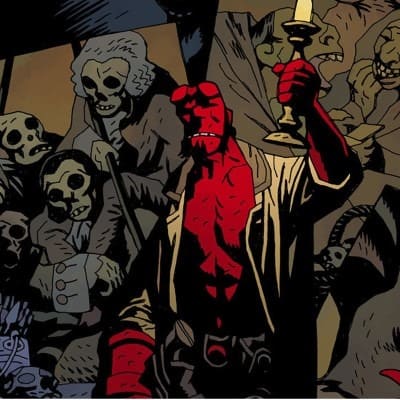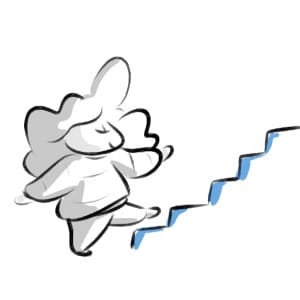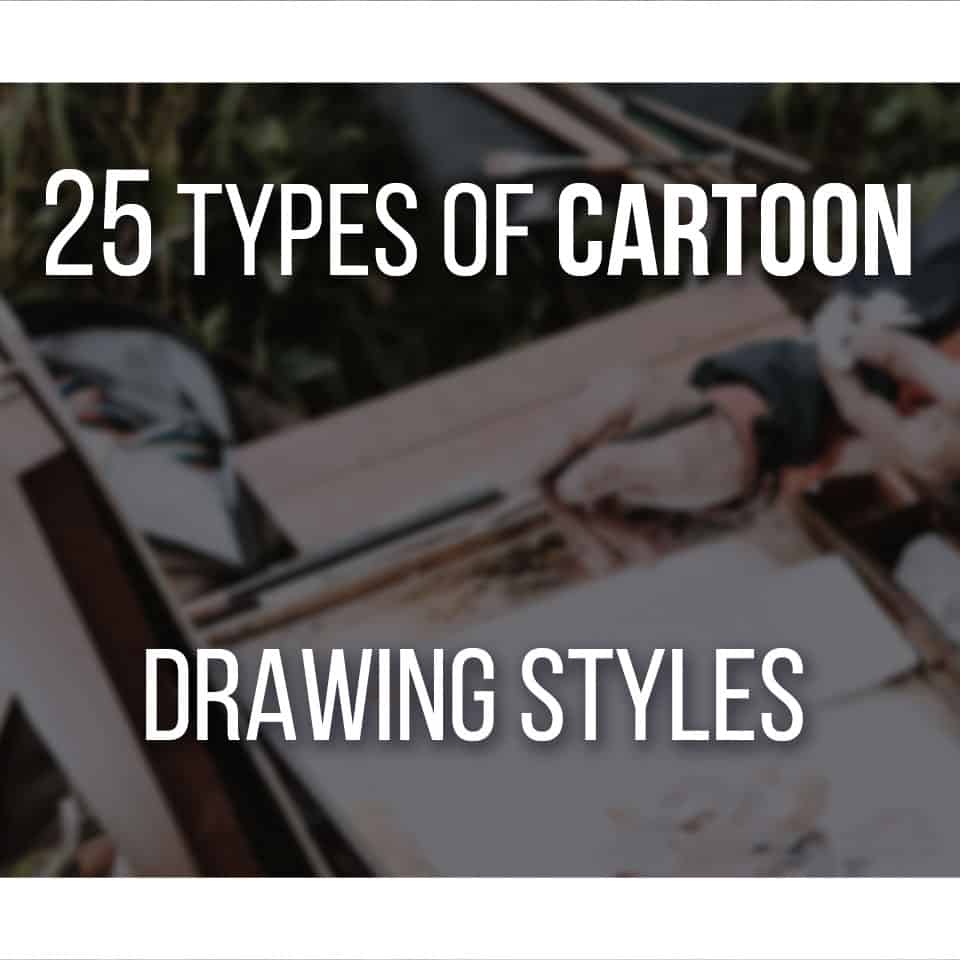If you’re just starting out with cartoon drawing, I have some great tips that I wish I knew when I was a beginner.
In fact, a lot of these I’ve learned along the years, and have done wonders to speed up my drawing skills into a successful cartoon artist.
Today I’m here to help you become a better artist, one tip at a time. So let’s start with my best cartoon drawing tips for beginners!
Update: Check out this video with some more Cartoon Drawing Tips!
Table Of Contents
- 1 1- ALWAYS Start With Basic Shapes
- 2 2- Use Guidelines On Your Sketches
- 3 3- Get Inspiration From Other Cartoon Artists
- 4 4- Squash And Stretch
- 5 5- Use Good Reference Material
- 6 6- Push The Limits Of Your Cartoon Drawing
- 7 7- Keep Your Art Clean
- 8 8- Watch More Cartoons (Even Older Ones!)
- 9 9- Start By Drawing What You See, Mix It Up Later!
- 10 10- Give (lots of) Emotion To Your Characters
- 11 11- Be Insane, Draw Nonsense!
- 12 12- Don’t Wait For Inspiration To Come, Act!
- 13 13- Try A Different Type Or Style Of Art
- 14 14- Drawing Takes Time, Don’t Rush It
- 15 15- Experiment With Different Drawing Tools
- 16 16- Progress Is Slower The More You Know
- 17 Summing It Up
1- ALWAYS Start With Basic Shapes
Every character and every environment is basically made of basic shapes that are refined.
A head is nothing more than a wobbly sphere on top of a body.
If you start with all these basic shapes in mind, it will make the process much easier when you’re cartoon drawing.
Not only that, but you’ll start imagining your cartoon character or environment in a 3D space much easier. It will also help you manipulate it and draw it again later on.

Especially if you’re also interested in animation, this process will help you out a LOT. It’s much easier to work with simple shapes and refine them later, than to start out with very complex shapes with lots of details.
This will also make the whole process of learning cartoon drawing much smoother, which is another cartoon drawing tip that I’ll talk about later in this post.
2- Use Guidelines On Your Sketches
Guidelines are there to help you, specially if you’re a beginner artist trying to draw in a cartoon style.
Learn to use and abuse them. You can use guidelines for everything! Find where every part of your character should be, and then actually draw it.
There’s an old proverb that says “Measure twice, cut once.”
What it basically means is that you should always take precautions before committing to something. And guidelines are there for just that!
With guidelines, you can test many things in your cartoon drawings, before committing to a final piece.
“Measure Twice, Cut Once.”
It’s much easier to find some important features like eyes, mouth, or even body parts like the wrists and torso if you have guidelines in place.

Even if you’re drawing an environment, always sketch up the rough layout first before committing to your artwork piece.
This way, you can test things out and see which layouts work better.
Once you’re happy with a rough sketch, you can clean everything up and go for a more finalized look.
3- Get Inspiration From Other Cartoon Artists
I tend to write about inspiration and motivation in my articles, and I still think it’s a very important factor in cartoon drawing, so I’m going to write about it here as well.
Following and interacting with fellow artists is, in my opinion, a very important step in your journey as an artist.
In fact, I always try to answer every question my student artists have on my Drawing Courses. I feel it doesn’t only help them improve their own artwork, but it also helps me in several ways.
Point being, remember to see many different artists with different cartoon styles! See which ones you like the most and try to understand their process.
You can read this article with 25 Types of Cartoon Drawing Styles (with Examples) to get inspired!
Many of these artists are self-taught and you can learn a lot by carefully watching their drawing process.
Also, feel free to copy their art so that you can practice. There’s nothing wrong with that as long as you just do it for practice purposes, and it will make you a better artist much quicker!
In fact, if you can learn different art styles by copying, you can then later on mix and match different artists styles with your own, and come up with a totally different cartoon drawing style!

There are a lot of possible outcomes with this process, so I would really focus on it.
Remember that a lot of artists have youtube, social media accounts with step by step processes, books, or even video courses, so there are many ways to see how each artist does their style.
I talk more about this in my article on Improving Your Art Style.
So if that’s something you want to cover in a bit more depth, be sure to check it out.
4- Squash And Stretch
Although this is mostly used as an animation principle, it really applies to drawing Cartoons as well!
Squashing and stretching your cartoon character helps it show weight and emotion. For example, if you want to make a very angry character stomping his feet on the ground.

You could squash his feet to better show the impact, and stretch his arm upwards as if he was landing from a jump!
Not only that, but it also helps you develop new cartoon styles and new characters.
For example, you can grab one of your previous characters and play with their proportions.
Maybe extend a leg and squash the head. With some extra modifications to outfits, hairstyles and more, you can already have a new character!
5- Use Good Reference Material
This is very important, and it’s not cheating! No matter how much other people tell you, using reference images is not cheating in art. In fact, there is no cheating in art.
Especially if you’re trying to draw something new that you haven’t seen a lot of, be sure to check reference images for it.
For example, if you want to draw a scene in Africa with elephants, but you’ve never been there or seen an elephant, get some reference!
Most of the times it’s actually better to grab several different pieces of reference from different points of view, and learn from them.
This way you can better see them in 3D and it will be MUCH easier to draw them on paper or your PC.
It doesn’t even have to be a reference of a specific object, environment or animal. Sometimes you’ll have difficulties drawing a specific thing, like for example, eyes.
It’s completely fine to grab some reference images of that specific body part or feature that you’re trying to draw and learn from that experience!

You can (and should) grab those images and even copy them for practice purposes. Learn from practicing with the originals. Grab them and draw over them!
Everything is fine, and this process will make you a better artist.
Now, if you’re having a hard time finding reference images, check out my article on 27 Art References And Resources For Artists. There are a lot of amazing sources there that you can browse.
6- Push The Limits Of Your Cartoon Drawing
Make the most of your cartoon drawing, don’t settle with basic shapes, and squashing and stretching your characters and environments. Push the limits!
Create perfectly squared faces, make an eye look like a Star, exaggerate your figures by making a super long leg and a very tiny one on the same character.

There is really no wrong way to go about this, keep drawing different and odd things and you’ll see that your skills will improve much faster than you think.
Just experiment a lot while drawing and don’t be afraid if some things just look silly or odd.
It’s all a matter of keeping up the practice and developing your cartoon drawing style.
7- Keep Your Art Clean
This is a cartoon drawing tip that applies to pretty much every art style, not just cartoon.
In fact, this is one of the 15 Drawing Tips for Beginner Artists that I have for everyone (read the other 14 here)!
Unless you have a very specific messy style doing your artwork, keep your final lines clean! It’s perfectly ok to sketch messy lines at first so that you can find the overall shapes first.

I always recommend for people to be messy in their sketches.
In fact, I do the same in my online drawing courses!
It helps me explore different ideas that I would most likely not have if I had started with only clean lines, and it also helps me explore proportions and features.
This doesn’t mean that you keep that way though.
Once your sketch is done, you’ll want to clean everything up and make it clear how your final cartoon drawing looks.
8- Watch More Cartoons (Even Older Ones!)
You’re never too old to watch cartoon movies and series!
Not only you’ll be having some fun watching cartoons, but you’ll also learn a lot from them. Pay attention to how everything was drawn and WHY they were drawn that way.
Does a character have a limp? Think about how the artist draws and shows that.
And not only that, if you pay attention you’ll also learn a lot of tiny details to create a specific mood or emotion in cartoon drawings.

In fact, a lot of cartoon drawings have very clear signals and drawing techniques to showcase specific emotions.
For example, have you noticed that when there’s a sad scene in a movie, it always tends to have very dark colors and even sometimes there are added details in the background like rain?
These are all visual triggers that cartoon artists (and even movie directors) use to help the viewer feel the emotion that is going on in the cartoon.
An additional small tip while watching cartoons: try to draw at the same time you’re watching them.
This will improve your drawing speed, how quickly you find the general shapes of characters (since the cartoon is always playing), and will make you learn different styles of cartoon drawing!
9- Start By Drawing What You See, Mix It Up Later!
Everything can come from a place of knowledge.
What I mean by that is that if you’re stuck drawing some sort of character or environment, remember that what you’re drawing is based on previous knowledge that you have.
For example, if you want to draw a summer beach, I’m sure that during your life you’ve either:
- went to the beach yourself
- has seen photos of the beach
This is why it’s important to start by drawing what you see.
Look around you, draw objects, draw rooms, draw environments. Need more? Search online for things you want to draw, search magazines, copy them and learn from them.
Especially at the start of your drawing skills, it’s very important to gather knowledge. And there’s no better way to gain knowledge than to study and practice using reference material.
If you’re drawing people, I recommend checking out these 7 free pose reference websites for artists.
“Drawing is vision on Paper.”
Andrew Loomis
You might be thinking: “But there are so many fantasy settings and creatures that don’t exist, no one has ever seen them!”.
You’re correct. But they are all a big blend of different things. For example, dragons.
Dragons are nothing more than big lizards with wings! Through your imagination, it’s very simple to create beings by mixing them together.
So, remember to fill up your knowledge “database” with as much as you possibly can, it will come in handy during your entire life!
10- Give (lots of) Emotion To Your Characters
Remember that while doing cartoon drawing you’re not looking to create realism. You must push the limits, as I said before, and exaggerate your drawings.
So focus on giving a specific emotion to your character while drawing them.
In fact, think about the personality of your character before you actually draw him. It’s much easier to give emotion to your character if you already know how he or she behaves.
So for example, if you’re doing a rebellious character that fights against the oppressive law, you can already start brainstorming what emotion to give them. Perhaps a very angry face with his fist shaking in the air.

Not only that, but it also helps you develop more of his stance, pose, and outfit. Remember that emotion doesn’t come only from the expression of the face, but from the whole character.
Always keep the personality, stance, and point of view of your character in mind while drawing him or her.
I would even encourage you to actually write down every little aspect of their life.
Just like something you would do in a roleplaying game like Dungeons and Dragons, listing the feats, strength, and weakness of your character.
And remember, no one likes a stale character; make them show emotion!
11- Be Insane, Draw Nonsense!
Think outside of the box.
Everyone has already seen Mickey Mouse, the wonderful and charismatic mouse in love with Minnie. The world doesn’t need a second one.
“The world today doesn’t make sense, so why should I paint pictures that do?” – Pablo Picasso
Stretch your imagination to its limits and see what you can come up with. And of course, for this to work you need to have that “knowledge database” that we’ve talked about before.
Mix and match different concepts, create chimeras, alien planets, distant futures or ancient impossible pasts.
And you don’t have to start by drawing anything in particular, scribble on a piece of paper until you’ve got an idea!

In fact, I found it to be quite a good exercise to draw nonsensical lines on a sheet of white paper and see shapes, animals, and characters there. Draw what you see in those lines!
Almost like looking at the sky and imagining what the clouds look like.
Once you get on the habit of drawing these nonsensical drawings that start making sense piece by piece, I assure you that you’ll start seeing your artwork, and the world, in a very different way.
12- Don’t Wait For Inspiration To Come, Act!
I know, I’ve already talked about inspiration, but this specific tip is a bit different!
If you sit idly by, 9 times out of 10, inspiration won’t come to you.
In fact, inspiration comes from a place of creativity and mindfulness. It’s not a magical on/off switch that switches whenever it wants.
“Inspiration exists, but it has to find you working”
Pablo Picasso
So if you’re stuck looking at a white page or a blank document in your computer, stop. Then, act on it!
Start scribbling, start drawing things you’re already used to, just do something.
You’re in control of your own inspiration. You just need to turn it on by actually drawing and working for it.
Now, by this, I don’t mean that you should push yourself to exhaustion. That’s not what I want you to do at all. Some rest is always needed from time to time.
What I want you to do is to grab inspiration and control it. Find what makes you inspired.
This changes completely from person to person, so I can’t quite pinpoint what you should do, but here are some suggestions:
- Watch movies on a theme you love
- Read a book from fiction
- Listen to your favorite music
- Go to the park and sketch passersby
- Go for a run around the neighborhood
- Play a video game
There are so many more things, but it all comes to who you are as a person, and what makes you tick.
All in all, simply don’t wait for inspiration to come, act on it. Create your own motivation (like I talk in this article here).
13- Try A Different Type Or Style Of Art
“Wait, isn’t this article about Cartoon Drawing? I don’t want to learn another style!”
I understand. I really do.
But, getting out of our comfort zone, or dabbling into new styles can really make you a better artist on a different style.
For example, as I’m sure you know, most people learn traditional anatomy before learning how to draw cartoons.
In fact, pretty much any artist has knowledge about color theory, shading, perspective and more. These are all art fundamentals that serve as a base for other styles of drawing.
Then, once artists feel comfortable with all those bases, they can branch out to new styles or refining their current style.
This is how cartoon drawing was created, simply by pushing the limits of the traditional art fundamentals until it turned into an actual style.
Now think about it. If you can learn a totally different style, and mix it with a current style that you already know, the possibilities are endless!
In fact, many artists have done so in the past.
For example, Mike Mignola has created his own style of art in the Hellboy comics by combining comic style art with Chiaroscuro, which is a very contrasting style of art.

Summing it up, always consider trying new art styles to improve your own style! There are so many possibilities of what you can come up with, it would be a mistake not to do so.
14- Drawing Takes Time, Don’t Rush It
This is mostly general drawing advice, but you need to know that drawing takes time.
Some people ask: “how much time does it take to draw a character? What about a house?”. And the answer is: It depends.
And I don’t mean it like it depends on the number of windows in the house or how detailed the house is, no. I mean, it depends on each person.
There are artists that can draw a full character in under 5 minutes. Others take over an hour to do the same thing. Each person is very, very different.
So take this small drawing tip: take your time.
I’m sure you know artists that do amazing drawing super quickly, but this doesn’t mean that you are inferior to them, it’s just another pace.
You will get quicker with time, and even if you don’t, your art is all that matters, not how fast or how slow you did it.
15- Experiment With Different Drawing Tools
A particular drawing style can be COMPLETELY different if you use another tool.
For example, if you draw an ant using a very large and wide brush, it will look much different than if you use a mechanical pencil.
This is why it’s important to try different drawing tools and see what you can come up with. Every little aspect of cartoon drawing matters. From style to tools, to inspiration.
And when I say different drawing tools, I don’t just mean traditional drawing tools.
In fact, if you’re using traditional drawing tools like pencils or brushes, I HIGHLY recommend you to try digital media for example. There are a lot of different and free drawing software you can use and have fun with.
And even if you are already using a drawing software on your computer to draw cartoons, be sure to either try new brushes and tools or to even try a totally new software!
A lot of software have completely different tools and behave in distinct ways, so it’s always a good time to try them.
16- Progress Is Slower The More You Know
When you’re learning a new skill, you are bombarded with knowledge, tips, and techniques. This is true for any skill.
It can actually be overwhelming.
But, if you manage to grab on to all that knowledge, you’ll learn a LOT in a very short amount of time.
This isn’t true for what’s coming up in the near future though. In fact, most skills are based on refining base knowledge.

What I mean by this is that once you know the basics of drawing, for example, you’ll be refining those basics for years to come.
And that learning curve takes time, creating amazing cartoon drawings takes time. So my tip here for you is: be patient and don’t stop drawing.
Summing It Up
For a beginner artist, these are just a few tips that can help you improve your cartoon drawing skills. I believe that if you follow every one of these tips, you will become a much better artist in a very short time.
So I hope these cartoon drawing tips have been helpful to you! Remember, keep drawing and have patience my artist friend.
Oh and go do some anatomy drawing exercises, like I mention here!

Patricia Caldeira is the main writer here at Don Corgi. She's an art teacher with over 20.000 happy students across many platforms and courses!
Enjoy your stay and as always:
Keep on drawing!








